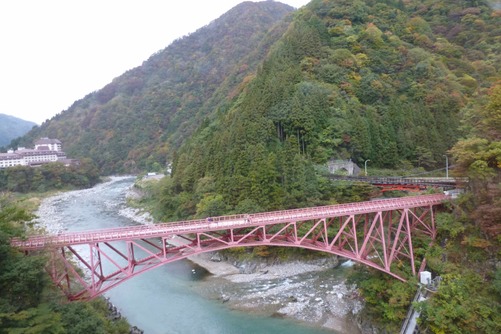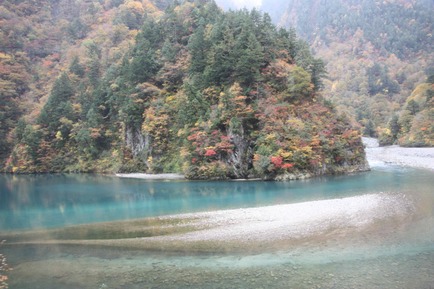
Breakfast done, it was a case of dropping the Black Monster and Madam's back pack at Reception, checking out and making our way a mere couple of hundred metres along the street to the headquarters of the Kurobe Torokko. The sight of a couple of traffic wardens waving batons and directing private vehicles and tour buses into their respective parking areas was enough to confirm that we were going to be dealing with significant numbers of fellow travellers.
We were booked on the second train for the morning, departing at 8:18, and the crowd for the 7:57 were queued up behind the barriers as we arrived. There's an interesting little variation on the booking side of things on the Torokko, in that your reservation gets you a seat in the carriage, but as far as which seat is concerned, it's a case of first in, best dressed.
They open the barriers about ten minutes before the scheduled departure time, and what follows isn't quite a stampede, but by the same token it isn't the casual stroll you'd be taking if you knew you had a pair of guaranteed seats either.

The actual journey starts with a climb through the first of many tunnels, emerging just before the 166-metre long Shin-Yamabiko Iron Bridge, the longest bridge on the route, and the red painted structure they use for the publicity material, then passes the Unazuki Dam, the first of the structures that brought the line into existence.
As you proceed from there there's a rather impressive castle-like structure that presumably fulfils some purpose related to generating electricity, though just what that purpose might be remains a mystery to this particular observer. The rest of the structures en route are predictably utilitarian.

Apart from the autumn leaves, which were the main reason for the crowds being there, and quite magnificent they were, as the images hereabouts illustrate, there are plenty of items of interest to catch the keen observer's eye. There are branches running off the main line, for example, and a long subterranean tunnel built to allow workers to get back down the mountain when winter snows remove the train from the transport equation.
Suspension bridges across the gorge at a couple of points allow workers and, presumably, trekkers, to cross from side to side, though one of them doesn't.'t have hand rails. That one's for the monkeys.